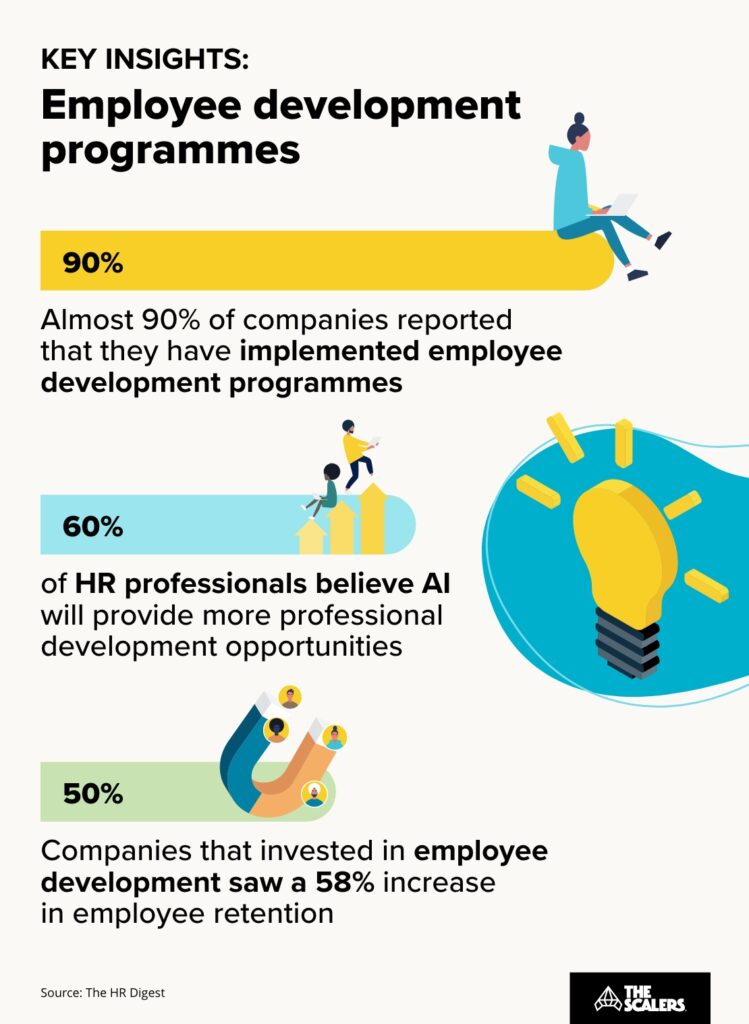If you’re looking to improve employee engagement and boost motivation in your company, this article’s for you.
Based on our experience building highly engaged and culturally aligned dedicated development teams, we’ve discovered the five best ways of promoting employee engagement.
But first, we’ll start by defining what this concept (really) means. After that, we’ll guide you into the strategies that can help you establish a positive work environment where everyone feels heard and empowered.
Let’s dive into it!
What is an engaged employee?
An engaged employee is deeply committed to their work, showcasing a profound sense of dedication and passion.
Thus, employee engagement reflects the extent to which employees genuinely care about and love their daily tasks and the strength of their connection with colleagues and the organisational culture.
The key components of employee engagement are the following:
- Leadership: Managers play a significant role in influencing engagement scores and fostering healthy, meaningful relationships within the team.
- Rewards and recognition: Appreciation enhances employee engagement and increases productivity and cooperation among team members.
- Professional growth: Supporting professional growth through training, learning opportunities, and challenging responsibilities is essential for employee engagement, preventing productivity decline, and ensuring a motivated and skilled workforce.
Now that you know the definition, it’s time you learn the five tips to increase employee engagement in your organisation.
How to improve employee engagement: 5 ways
Incorporate these five practices into your business to have a significant impact on employee engagement — the strategies that earned us a Great Place to Work certification over the past two years.
1. Measure employee engagement
You cannot improve employee engagement if you don’t know what your starting point is. That’s why it’s essential to measure the rate of engagement in your organisation.
The simplest and most effective way of doing this is to collect data through a survey to understand how your current and new employees feel, what areas you need to improve, and create a benchmark for the future. You can either design a custom, relevant, and actionable survey for your business or simply use a pre-existing online survey.
For instance, Gallup’s Q12 survey is one of the best questionnaires to help you improve employee engagement. Through a series of 12 carefully crafted questions curated after studying over 2.7 million workers worldwide, Gallup enables you to understand precisely what your employees need to perform to their maximum potential.

How to improve employee engagement scores?
One of the common mistakes that companies make when conducting surveys is to do them infrequently, sometimes even once a year. Unfortunately, annual surveys fail to capture an employee’s current engagement levels and don’t provide a complete understanding of their thought process.
Instead, conduct frequent, short pulse surveys that accurately capture an employee’s day-to-day thoughts. Doing so, allows you to receive regular feedback all year round and helps you improve workplace engagement.
Plus, it can contribute to addressing concerns related to employee turnover, employee feedback, and employee experience.
And last but certainly not least, review the data, share the outcomes with your team, and dedicate resources to address the ideas that result from the surveys.
2. Prioritise employee wellness
Wellness, both physical and mental, is one of the most overlooked factors in employee engagement.
According to a Mental Health America (MHA) study, 80% of employees agree that stress from work affects their relationships with friends, family, and coworkers.
As an organisation, it’s important to keep regular tabs on the health of your employees:
- Does your company encourage a healthy work-life balance?
- Do you promote a psychologically safe work environment?
- Does your company culture create a welcoming space that is built on trust?
- Do your employees have access to healthy foods at work?
Addressing these critical questions and implementing practices to promote employee wellness will significantly improve employee engagement.
Some simple ways to promote employee wellness include sponsoring workout classes, offering fitness subsidies, encouraging a healthy lifestyle through nutrition and fitness talks, offering access to meditation classes, and urging employees to take mental health days to focus on themselves.
3. Encourage professional and personal development
According to Gallup, the number one reason why employees leave a job is because of the lack of development and career advancement. And with today’s millennials and Gen-Z dominating the global workforce, professional and personal growth has become an unwritten yet implied clause in every employee’s contract.
However, many organisations still don’t actively encourage professional growth at work.
In fact, only 3 in 10 employees believe that someone at work encourages their development. If businesses were to improve employee engagement and double that number from three to six, they could realise an 11% improvement in profitability and a 6% increase in customer engagement. That’s the power of encouraging your workforce and finding a great way to enhance their skills.
“Highly engaged employees make the customer experience. Disengaged employees break it.”

By understanding the unique talents and strengths your team brings to the table, you can find projects and roles that they will excel in and grow into — both professionally and personally.
Employee engagement is truly about identifying their wins and misses, constantly motivating and encouraging them, holding them accountable, and connecting them with mentors and people they can learn.
When people grow, businesses grow, too.

4. Foster personal connections
One of the simplest ways to improve employee engagement within your organisation is to encourage healthy personal relationships among colleagues.
A good employer will always create opportunities for people to build meaningful friendships because it paves the way for sound company culture. However, it is also important not to manufacture friendships but instead promote a healthy, interactive environment for people to get to know each other.
It can be something as simple as inviting your team for drinks after work, planning a potluck, setting up a game night, or even organising a quick team-building activity in between meetings.
5. Focus on purpose
An attractive salary package and employee-centric benefits are great, but today’s modern workforce needs more. They need purpose and meaning.
While many managers believe that simply putting the organisation’s mission statement on a wall is enough, employees tend to disagree.
As a business leader, you should consider taking some time out to study your company’s values and mission. Then, examine how you’re aligning them with the goals of your workforce. The key is to ensure that your employees understand what your organisation stands for and how it aligns with their values and purpose.
This not only helps improve employee engagement but also makes your workforce excited to be at work. At the end of the day, that’s what really matters — making your employees feel like they’re a part of something bigger than their role or their current project.

In summary
And it’s a wrap!
We hope the five ideas to improve employee engagement listed in this article will contribute to building a successful workplace in your company.
Key takeaways
-
1
Employee engagement is the extent to which employees are committed to their work, demonstrating dedication, passion, and a strong connection with colleagues and organisational culture.
-
2
Leadership, rewards and recognition, and professional growth influence employee engagement.
-
3
Regular, short pulse surveys are essential for understanding and improving employee engagement.
-
4
Employee physical and mental wellness significantly impacts engagement, making it crucial for organisations to promote a healthy work-life balance and a psychologically safe environment.
-
5
Actively encouraging professional and personal development is crucial for retaining employees, as a lack of growth opportunities is a leading reason for leaving a job.
-
6
Creating opportunities for employees to build meaningful friendships and promoting a healthy, interactive environment contributes to a positive company culture and improved engagement.
-
7
Aligning organisational values and mission with employees’ goals and values fosters a sense of purpose, leading to increased engagement and a workforce excited to contribute.
If you’re interested in building a 100% dedicated and engaged development team in the heart of Bangalore, India, feel free to reach out to us by filling out this contact form. One of our senior executives will get back to you within 24 hours.
Until then, good luck implementing the employee engagement strategies in this guide!
Build Your Team,
Not Just a Contract
With The Scalers’ offshore dedicated development team, you get engineers who join your workflow for the long run. Grow steadily, stay flexible, and work with people who care about the product as much as you do.








